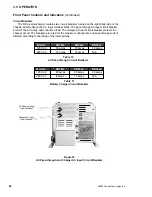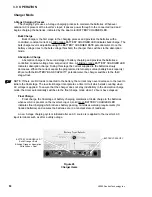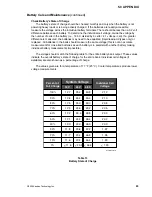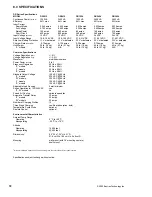
5.0 APPENDIX
61
©2000 Xantrex Technology Inc.
Battery Care and Maintenance
To get the best performance from an inverter system, the batteries must be properly set up and
maintained. This includes setting the proper voltages for Bulk and Float charging. Monthly, the
batteries should be Equalize charged (vented batteries only) and the water level checked and
maintained (see Cautions below). In addition, the battery terminals should be inspected, cleaned
and re-torqued if necessary.
Neglecting any of these items may result in poor inverter performance and greatly reduced
battery life.
Charge Rate
The maximum safe charge rate is related to the size and type of the batteries. Standard
vented lead acid batteries (with removable caps) can be charged at a high rate, equal to their
capacity. Small batteries may require a lower charge rate. Check with your battery manufacturer
for the proper battery charging rate for the batteries used in the system.
Bulk Voltage
This is the maximum voltage the batteries will be charged to during a normal charge cycle.
Gel cell batteries are set to a lower value and non-sealed batteries are set to a higher voltage
setting.
Float Voltage
The Float voltage is set lower than the Bulk voltage and provides a maintenance charge on
the batteries to keep them in a ready state.
Temperature Compensation
For optimal battery charging, the Bulk and Float charge rate should be adjusted according to
the temperature of the battery. This can be accomplished automatically by using a Battery
Temperature Sensor (BTS). The sensor attaches directly to the side of one of the batteries in the
bank and provides precise battery temperature information.
Equalization Charging
Every month or two the batteries should be Equalize charged. This helps to remove sulfate
buildup on the battery plates and balances the charge of individual cells. Batteries that are not
equalized charged can be damaged by sulfate buildup, thus sealing off a percentage of the
plates and reducing battery capacity.
Equalize charging also produces gassing which stirs up the electrolyte mixture and helps
distribute the acid more evenly. Batteries that are not equalize charged may have the sulfuric acid
accumulate at the bottom of the battery, potentially damaging the plates. At the same time, the
electrolyte at the top of the battery gets watery. This is call stratification.
CAUTION: BECAUSE A HIGHER VOLTAGE IS USED TO EQUALIZE CHARGE THE BATTERIES,
ANY DC LOADS MUST BE DISCONNECTED BEFORE AN EQUALIZATION CHARGE IS
STARTED.
CAUTION: EQUALIZATION SHOULD BE DONE FOR STANDARD ELECTROLYTE VENTED
BATTERIES ONLY. SEALED OR GEL CELL BATTERIES SHOULD NOT BE EQUALIZE
CHARGED. CONSULT YOUR BATTERY SUPPLIER FOR DETAILS ON EQUALIZE CHARGING
FOR THE BATTERY TYPE IN YOUR SYSTEM.
Summary of Contents for Trace DR Series
Page 1: ...Installation Operator s Manual DR Series Inverter Charger ...
Page 2: ......
Page 81: ......
Page 82: ......
Page 83: ......
















































